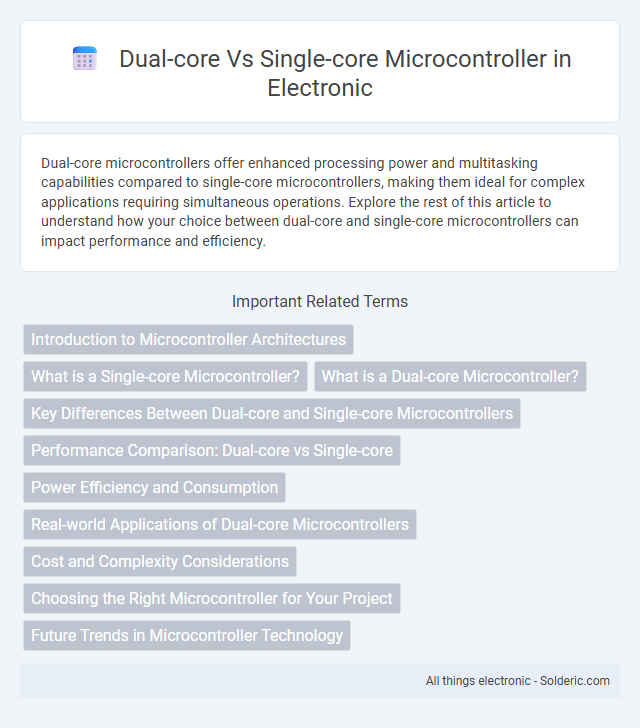Dual-core microcontrollers offer enhanced processing power and multitasking capabilities compared to single-core microcontrollers, making them ideal for complex applications requiring simultaneous operations. Explore the rest of this article to understand how your choice between dual-core and single-core microcontrollers can impact performance and efficiency.
Comparison Table
| Feature | Dual-core Microcontroller | Single-core Microcontroller |
|---|---|---|
| Number of Cores | 2 processing cores | 1 processing core |
| Performance | Higher throughput, parallel task execution | Lower throughput, sequential processing |
| Power Consumption | Typically higher due to multiple cores | Lower power usage |
| Cost | Generally more expensive | Cost-effective |
| Use Cases | Real-time applications, multitasking, complex processing | Simple applications, low power tasks |
| Complexity | More complex programming and debugging | Simpler development process |
| Memory Management | Advanced shared or separate memory architectures | Single memory space, simpler management |
Introduction to Microcontroller Architectures
Dual-core microcontrollers integrate two processing cores on a single chip, enabling parallel execution of tasks to enhance performance and efficiency compared to single-core microcontrollers, which operate with one processing core handling sequential instructions. Single-core microcontrollers are simpler, consume less power, and are suitable for basic control applications, while dual-core architectures support more complex, real-time workloads by distributing processes and reducing latency. Architectural differences such as shared caches, inter-core communication, and independent peripherals define their operational capabilities and impact system design choices in embedded systems.
What is a Single-core Microcontroller?
A single-core microcontroller contains one central processing unit (CPU) that executes instructions sequentially, making it suitable for simple and cost-effective embedded applications. It integrates key components like memory, timers, and input/output peripherals within a single chip, providing efficient control over hardware. Single-core microcontrollers excel in low-power consumption and predictable performance, ideal for real-time systems with limited computational demands.
What is a Dual-core Microcontroller?
A dual-core microcontroller integrates two processing cores within a single chip, enabling parallel execution of tasks and improved multitasking capabilities compared to single-core microcontrollers. This architecture enhances system performance, reduces latency, and allows efficient handling of complex applications such as real-time processing, automotive control, and IoT devices. By distributing workloads between cores, dual-core microcontrollers optimize power consumption and increase overall processing speed without significantly increasing hardware size or cost.
Key Differences Between Dual-core and Single-core Microcontrollers
Dual-core microcontrollers feature two processing units that allow simultaneous task execution, enhancing multitasking and overall performance compared to single-core microcontrollers, which have only one processing unit. Your choice between dual-core and single-core microcontrollers affects power consumption, with dual-core often consuming more energy due to parallel processing capabilities. Single-core microcontrollers tend to be simpler, more cost-effective, and suitable for less complex applications, whereas dual-core microcontrollers excel in handling demanding, real-time tasks requiring high processing efficiency.
Performance Comparison: Dual-core vs Single-core
Dual-core microcontrollers deliver significantly higher processing power than single-core counterparts by enabling parallel task execution and efficient multitasking, resulting in faster data processing and improved real-time responsiveness. Single-core microcontrollers, limited to sequential task execution, often face bottlenecks in complex applications requiring simultaneous operations or higher computational throughput. In performance-critical scenarios such as signal processing, automotive control, and IoT devices, dual-core architectures offer superior efficiency and reduced latency.
Power Efficiency and Consumption
Dual-core microcontrollers offer improved power efficiency by dynamically distributing processing tasks between cores, allowing one core to enter low-power states while the other remains active, reducing overall energy consumption. Single-core microcontrollers typically consume more power during intensive tasks as the sole core handles all operations without load balancing, leading to higher peak power usage. Optimizing power management in dual-core systems enables longer battery life, especially in applications requiring multitasking and real-time performance.
Real-world Applications of Dual-core Microcontrollers
Dual-core microcontrollers enable enhanced performance and multitasking capabilities in real-world applications like automotive control systems, industrial automation, and IoT devices by allowing simultaneous processing of multiple tasks. You benefit from improved response times and energy efficiency in applications that require complex data handling, such as sensor fusion, motor control, and communication protocols. These dual-core designs outperform single-core microcontrollers by distributing workloads and reducing latency in time-critical operations.
Cost and Complexity Considerations
Dual-core microcontrollers typically incur higher costs due to increased silicon area and more complex manufacturing processes compared to single-core variants. The added complexity of managing inter-core communication and synchronization demands advanced development tools and expertise, potentially raising project expenses. Single-core microcontrollers remain more cost-effective and simpler to implement for straightforward applications, making them ideal for budget-sensitive or less complex designs.
Choosing the Right Microcontroller for Your Project
Choosing the right microcontroller for your project depends on the processing demands and complexity of the application. Dual-core microcontrollers offer enhanced performance by handling multitasking efficiently and improving real-time responsiveness, making them ideal for advanced applications like IoT devices, robotics, and multimedia processing. Single-core microcontrollers, with simpler architecture and lower power consumption, suit basic tasks, cost-sensitive projects, or applications with minimal processing requirements, ensuring efficient use of resources tailored to your project's needs.
Future Trends in Microcontroller Technology
Dual-core microcontrollers offer increased processing power and energy efficiency compared to single-core counterparts, supporting complex applications such as IoT devices and real-time data processing. Future trends indicate a shift towards multi-core architectures with enhanced parallelism and integration of AI capabilities directly on-chip. Your projects can benefit from these advancements by leveraging faster computation and improved multitasking in embedded systems.
Dual-core vs Single-core microcontroller Infographic

 solderic.com
solderic.com